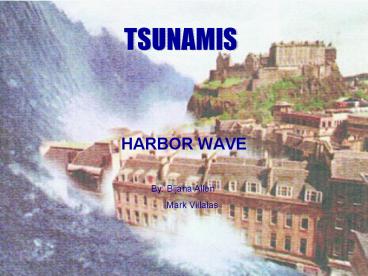TSUNAMIS PowerPoint PPT Presentation
1 / 13
Title: TSUNAMIS
1
TSUNAMIS
- HARBOR WAVE
By Bijana Allen Mark Villalas
2
Main Points
- Characteristics of Tsunamis
- How are they caused?
- Human and Environmental Impacts
- Overview of Past Tsunamis
- Asian Tsunami of 2004
- Tsunami Detection/ Warning Alerts
- DART Warning System
3
What are Tsunamis?
- Japanese term meaning harbor wave
- Confused with tidal waves, but they have nothing
to do with the tides - A result of sudden vertical faulting in the
ocean floor caused by earthquakes, volcanoes, and
submarine landslides - Most tsunamis are a byproduct of earthquakes
4
Characteristics of Tsunamis
- The speed of the tsunami is greater in deeper
water. Waves are unnoticeable. - - Speeds up to 700 Kilo/ Hr
- - Equivalent to an aircraft going 435
Miles/ Hr. - Speed decreases in shallow water, but the height
of the waves increases dramatically. Up to 100
miles high. - Water leaves quickly from the shore before the
tsunami hits.
5
Causes
- Sea floor abruptly deforms and vertically
displaces the overlying water. - Large vertical faulting occurs at plate
boundaries. - Subduction earthquakes are effective in creating
tsunamis. - When the Oceanic Plate is subducted beneath a
Continental Plate, it brings down the lip of the
Continental Plate with it. Eventually, too much
stress is put on the lip and it snaps back,
sending shockwaves through the Earths crust,
causing a Undersea Earthquake. Resulting in a
tsunami - http//www.tsunami.noaa.gov/animations/tsunami_gen
esis.avi
6
Human Environmental Impacts
- Destroying coral reefs in many countries across
Asia including Indonesia, Sri Lanka, and
Bangladesh making way for shrimp farms and other
economic choices impacted them by eliminating the
natural protection of the reefs. - Many people were saved on the Surin Island chain
of Thailands coast because the coral reefs acted
like a buffer to take some of the impact of the
tsunami - The mangroves along with coastal sand dunes were
viewed as obstacles during resort construction
and therefore removed - These natural barriers may have blocked some of
the force of the tsunami. Subsequently the homes
and resorts offered little resistance to the
fierce tsunami - Ecosystems such as forests, vegetation, coastal
wetlands, rock formations, animals, plants, and
groundwater sustained severe damage - Concern for the polluted water supplies because
of solid and liquid waste as well as industrial
chemicals. - The extent of the environmental impact will take
years and significant resources to repair and
restore damages.
7
Overview of Past Tsunamis
The Pacific Tsunami Warning Center created
Wikepedia.com
8
Asian Tsunami of 2004
- Before
After - (Aceh Province in Sumatra, Indonesia)
9
Tsunami Detection/ Warning Alerts
- Difficult because tsunamis speed is faster in
deep water with a minimum height and a network of
sensors is needed to detect it - Its a bigger challenge to set up a communication
infrastructure to issue warnings - Pacific Ocean already has warning systems due to
frequent earthquakes in the region. - Indian Ocean on the other hand does not have any
warning systems
10
Ache, Indonesia
- The Aftermath
11
DART Warning System
- Deep-ocean Assessment and Reporting of Tsunamis
(DART) - First one launched in the Indian Ocean on Dec. 1,
2006 as a result of the devastating Asian Tsunami
in 2004. - The new system will provide the U.S. with nearly
100 detection capability for its coastal
regions, allowing response within minutes. - It will also monitor throughout the entire
Pacific and Caribbean basins, providing tsunami
warning for regions bordering half of the worlds
oceans. - A total of 32 DART systems will be deployed all
around the world by mid-2007
12
Recap of Main Points
- Characteristics of Tsunamis
- How are they caused?
- Human and Environmental Impacts
- Overview of Past Tsunamis
- Asian Tsunami of 2004
- Tsunami Detection/ Warning Alerts
- DART Warning System
13
Final Thought
- Although the Asian tsunami created a great
tragedy too many people, it also did a lot to
educate us globally, and to bring awareness to
tsunamis and earthquakes in general. The
devastation in these countries helped to unite
the world together in an effort to provide relief
to the affected people. Governments and
individuals donated billions of dollars to
rebuild and help the people of these countries in
need. Similarly, the tragedy of the situation
brought awareness to the need for a global alert
system in order to minimize deaths associated
with tsunamis.

